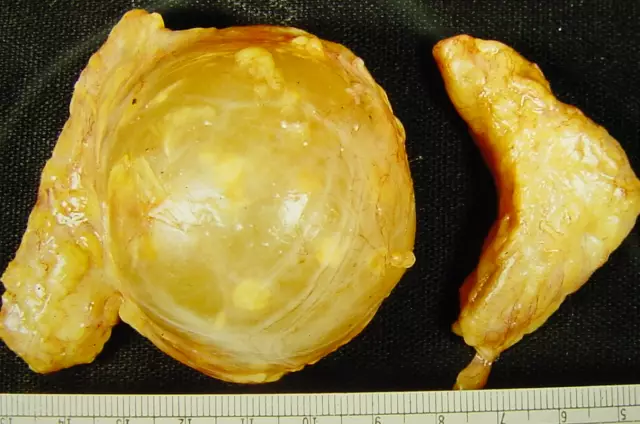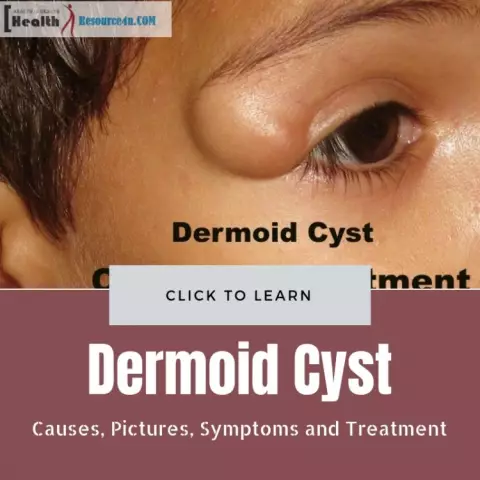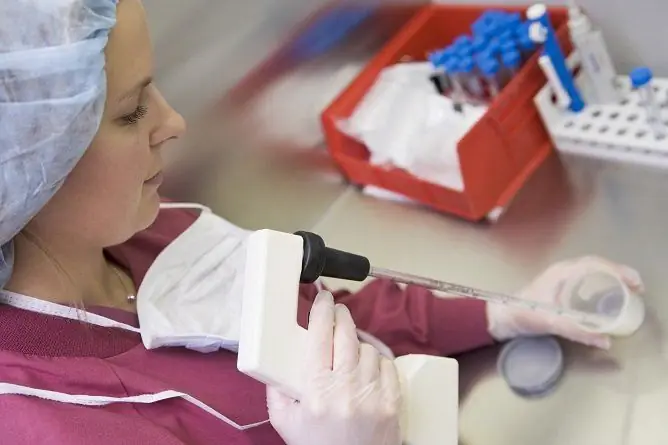- Author Rachel Wainwright [email protected].
- Public 2023-12-15 07:39.
- Last modified 2025-11-02 20:14.
Adrenal cyst

The adrenal glands are a paired organ, human endocrine glands located in close proximity to the upper poles of the kidneys, the main function of these structures is the production of hormones in the human body (adrenaline, norepinephrine, corticosteroids, sex hormones).
An adrenal cyst is a benign, hollow, hormonally inactive single-chamber (less often multi-chamber) formation filled with fluid, which has different localization in the projection of the adrenal gland and is clinically asymptomatic in most cases. An adrenal cyst is a rare endocrine gland pathology diagnosed randomly during an extended ultrasound examination of the abdominal organs. In ultrasound diagnostics, the adrenal cyst has the form of a round or oval formation with a smooth inner surface and clear even contours with echogenic thin walls and anechoic contents. The adrenal cyst does not affect the hormone production process and does not change the hormonal background of the patient's body as a whole.
Adrenal cysts can be of various sizes. In medical practice, cases have been recorded when the adrenal cyst exceeded 10 cm in size. The size of the cystic mass affects the severity of symptoms.
According to morphological characteristics, 4 types of adrenal cysts are distinguished:
- A true epithelial cyst of the adrenal gland is a cystic formation lined with a cylindrical epithelium of the adrenal cortex or the epithelium of migrated cells of the secretory segment of the kidney;
- A true endothelial cyst of the adrenal gland is a cystic formation resulting from ectasia (expansion) of the lymphatic and blood vessels;
- A parasitic cyst of the adrenal gland is a cystic formation that forms as a result of the invasion of hydatid echinococcus;
- An adrenal pseudocyst is a residual phenomenon after hemorrhage in healthy adrenal tissue or a tumor of the gland. Such a formation does not have an epithelial lining, and can reach significant sizes.
Adrenal cysts are more common as solitary, unilateral cystic formations. In rare cases, multiple cystic lesions or bilateral changes are diagnosed.
Adrenal cyst: symptoms and diagnosis
When diagnosing an adrenal cyst, an important stage in the study of a neoplasm is to determine the malignant potential of the cyst. When conducting an examination, the adrenal cyst should be differentiated from other tumor formations of the adrenal glands and kidneys, cancer metastases, periadrenal aneurysm, retroperitoneal teratoma, liposarcoma. If an adrenal cyst is detected, the diagnosis of the formation should include the determination of the hormonal background of the patient's body, X-ray examination, magnetic resonance imaging with the introduction of contrast, which will exclude the tumor (cystic formations do not accumulate contrast).
In some cases, with cystic formations closely adjacent to the kidney, there is a possibility of diagnosing an adrenal cyst as a cyst of the upper pole of the kidney. It is possible to reliably recognize the true nature of education during MRI and CT.
Giant adrenal cysts are difficult to diagnose. Often, such neoplasms are falsely diagnosed as pancreatic pseudocysts, the true diagnosis is established only during surgery.
The adrenal cyst is asymptomatic in most cases. When the adrenal cyst reaches a large size, the symptoms of formation can manifest as follows:
- Increased blood pressure (when compressed by the cystic formation of the renal artery);
- Painful sensations in the lower back, back, side from the side of the adrenal gland lesion;
- A feeling of squeezing in the peritoneum;
- Dysfunction of the kidneys (with large sizes of formation and squeezing of the kidney itself).
When diagnosing an adrenal cyst, symptoms will depend on the location and size of the formation.
Adrenal cyst: treatment, prognosis
The correct diagnosis when an adrenal cyst is suspected largely determines the treatment of the formation. As a rule, with relatively small sizes (up to 4 cm) of adrenal cysts, treatment is not required. Such patients are shown regular (every 6 months) CT monitoring of the neoplasm to track the dynamics of its development. With a significant growth of the adrenal cyst, the risk of developing complications such as purulent inflammation of the cyst, rupture of the cyst, and internal bleeding increases.

At present, conservative treatment is not practiced for adrenal cysts. For the effective treatment of adrenal cysts, radical techniques are used - cystectomy, partial adrenalectomy.
Cystectomy is a radical surgical excision of a cystic formation and its membrane.
Partial adrenalectomy - removal of a benign tumor with maximum preservation of healthy tissue of the gland. During such an operation, an urgent analysis of the excised preparation is performed to determine the appropriate level of intervention.
Preserving adrenal reserve tissue provides a higher standard of living (stress response) and also avoids hormone replacement therapy.
Modern methods of performing an operation to remove an adrenal cyst suggest a traditional lumbar approach or a laparoscopic approach. The choice of a cyst treatment method, as well as individual indications for surgical excision of the formation, are determined jointly by a surgeon and an endocrinologist.
Indications for removal of an adrenal cyst by laparoscopic access are benign, hormonally inactive cystic formations of small size (from 2 to 6 cm) without signs of invasion into adjacent tissues.
The advantages of the endoscopic technique for the operation to remove the adrenal cyst are:
- Minimally invasive technique (the least mechanical tissue damage);
- Visualization of the adrenal glands, blood vessels, as well as the neoplasm itself under high magnification;
- Less blood loss than with traditional lumbar access;
- Reducing the period of disability, quick recovery after surgery;
- Safety and speed of the operation.
Laparoscopic technique also entails certain risks:
- The likelihood of leaving a part of the neoplasm with multifocal lesions of the adrenal gland;
- Increased risk of recurrence of education.
If the operation is successful, the prognosis is favorable.
YouTube video related to the article:
The information is generalized and provided for informational purposes only. At the first sign of illness, see your doctor. Self-medication is hazardous to health!






